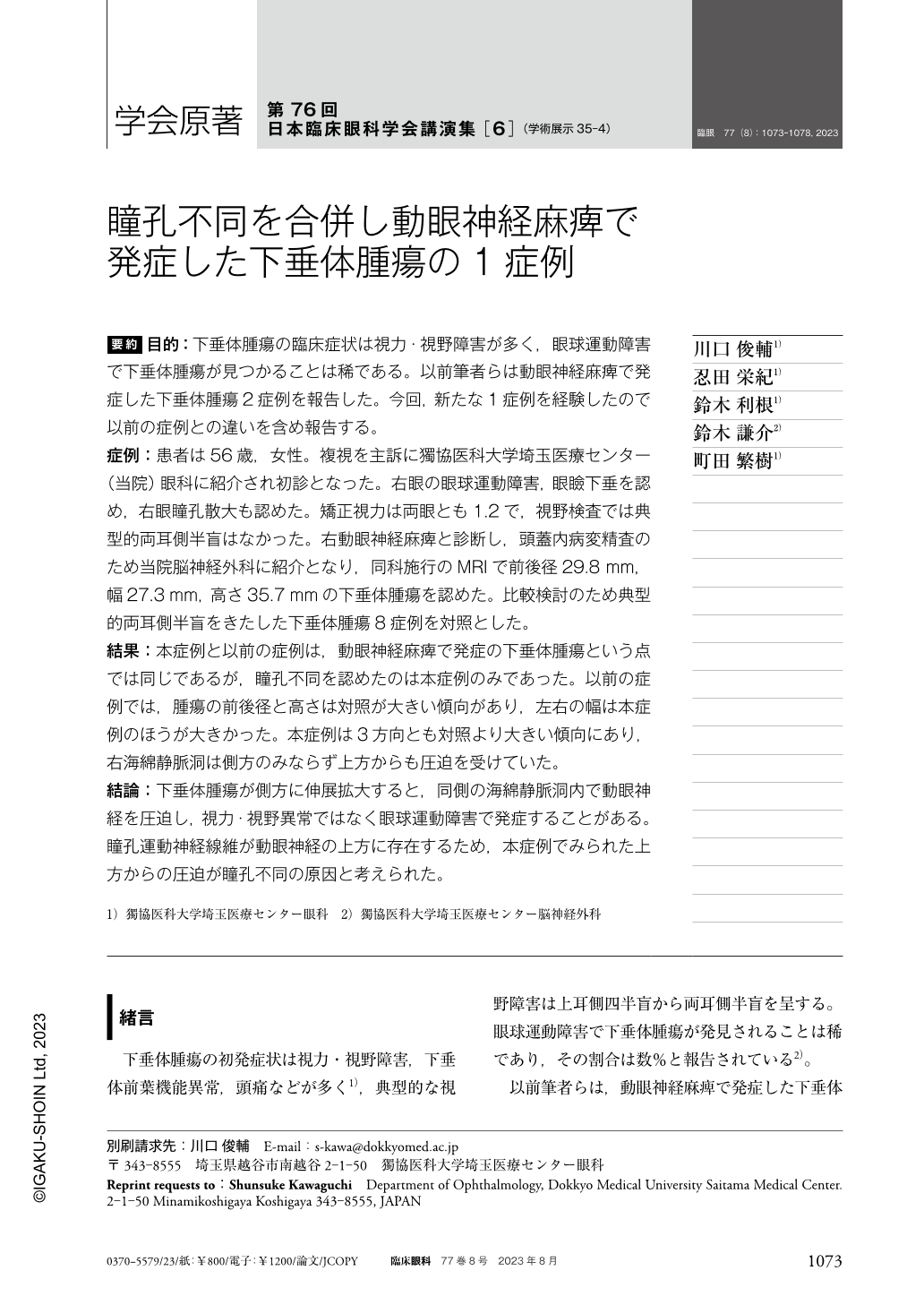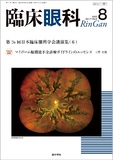Japanese
English
- 有料閲覧
- Abstract 文献概要
- 1ページ目 Look Inside
- 参考文献 Reference
要約 目的:下垂体腫瘍の臨床症状は視力・視野障害が多く,眼球運動障害で下垂体腫瘍が見つかることは稀である。以前筆者らは動眼神経麻痺で発症した下垂体腫瘍2症例を報告した。今回,新たな1症例を経験したので以前の症例との違いを含め報告する。
症例:患者は56歳,女性。複視を主訴に獨協医科大学埼玉医療センター(当院)眼科に紹介され初診となった。右眼の眼球運動障害,眼瞼下垂を認め,右眼瞳孔散大も認めた。矯正視力は両眼とも1.2で,視野検査では典型的両耳側半盲はなかった。右動眼神経麻痺と診断し,頭蓋内病変精査のため当院脳神経外科に紹介となり,同科施行のMRIで前後径29.8mm,幅27.3mm,高さ35.7mmの下垂体腫瘍を認めた。比較検討のため典型的両耳側半盲をきたした下垂体腫瘍8症例を対照とした。
結果:本症例と以前の症例は,動眼神経麻痺で発症の下垂体腫瘍という点では同じであるが,瞳孔不同を認めたのは本症例のみであった。以前の症例では,腫瘍の前後径と高さは対照が大きい傾向があり,左右の幅は本症例のほうが大きかった。本症例は3方向とも対照より大きい傾向にあり,右海綿静脈洞は側方のみならず上方からも圧迫を受けていた。
結論:下垂体腫瘍が側方に伸展拡大すると,同側の海綿静脈洞内で動眼神経を圧迫し,視力・視野異常ではなく眼球運動障害で発症することがある。瞳孔運動神経線維が動眼神経の上方に存在するため,本症例でみられた上方からの圧迫が瞳孔不同の原因と考えられた。
Abstract Purpose:The clinical symptoms of pituitary tumors include losses of the vision and visual field although pituitary tumors are already detected due to abnormalities of eye movements. We have previously reported two cases of pituitary tumors causing oculomotor nerve palsy. We will now compare the clinical characteristics of an additional case we encountered with those of the previous cases.
Case:A 56-year-old woman was presented to us with diplopia. We observed dysmotility, ptosis, and dilattion of pupil in her right eye. The best-corrected visual acuity was 1.2 in both eyes, and visual field examination did not reveal typical bitemporal hemianopsia. With a diagnosis of a right oculomotor nerve palsy, she was referred to the neurosurgery department for a detailed examination of intracranial lesions. MRI revealed a pituitary tumor with antero-posterior diameter, height and a size of 29.83, 35.72 and 27.29 mm respectively. Eight cases of pituitary tumors with typical bitemporal hemianopsia were also studied as controls for comparison.
Results:There was development of anisocoria in the present case, differentiating it from the previous two cases. The tumors in the previous cases had greater width and a shorter antero-posterior diameter and height compared to those of the controls. All three dimensions of the present tumor were greater than those of the controls. The right cavernous sinus was compressed not only from the side but also from above.
Conclusions:If a pituitary tumor grows laterally, it may compress the oculomotor nerve in the ipsilateral cavernous sinus, resulting in eye movement abnormalities instead of loss of the vision and the visual field. The anisocoria observed in the present case may be attributable to compression to the oculomotor nerve from above since pupillary motor fibers exist in the upper portion of the oculomotor nerve.

Copyright © 2023, Igaku-Shoin Ltd. All rights reserved.


